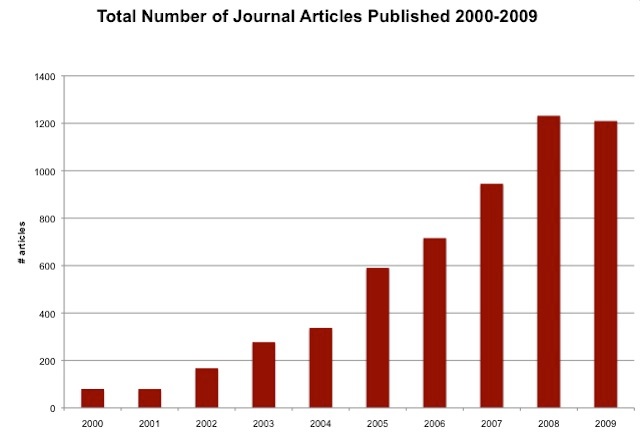News | January 17, 2012
Impact of NASA EOS Instrument Data on the Scientific Literature: 10 Years of Published Research Results from Terra, Aqua, and Aura

Chart from the paper "Impact of NASA EOS Instrument Data on the Scientific Literature: 10 Years of Published Research Results from Terra, Aqua, and Aura". Credit: Gene Major
Sharon Ray, NASA Jet Propulsion Laboratory
Published in Issues in Science & Technology Librarianship, the paper "Impact of NASA EOS Instrument Data on the Scientific Literature: 10 Years of Published Research Results from Terra, Aqua, and Aura" by Gene R. Major analyzes the last ten years worth of publications that refer to data from instruments that are part of NASA's Earth Observing System. The abstract, table of contents, and an excerpt from the paper are provided below.
Abstract
In the absence of formal data set citation standards in the literature, there is no quantitative information on the connection between data distributed from NASA's Earth Observing System (EOS) data centers and subsequent research published using EOS data. This paper provides an analysis of a 10-year citation history of research using EOS instrument data in the peer reviewed literature, which illustrates that the high volume of published EOS-related papers is indicative of the use of data from the NASA DAACs and comprises a significant contribution to the body of scientific knowledge about the Earth's climate.
The paper contains the following sections:
Introduction
Data Distribution
Methodology
EOS Instrument Data Cited in Scholarly Journals
Distribution of Papers Citing EOS Instruments
The Impact of EOS Research
EOS Data Distribution and Published Literature
Conclusions
Acknowledgements
References
Excerpt (from the section, "Conclusions")
Papers published citing the use of EOS instrument data have greatly contributed to the body of knowledge about Earth system processes. Although authors will cite that a specific EOS instrument was used, the citation of specific datasets in the peer-reviewed literature, however, is lacking, and the prospects for consistent citation in the future are not bright, though there is considerable movement towards establishing data citation standards (Green 2009). Many publishers do not allow the explicit citation of datasets in a format similar to citing journal articles and many authors do not explicitly cite the source of the data in their papers. The scholarly citation of datasets in scientific publishing has been widely discussed in Green (2009) and in Altman and King (2007).
The German Research Foundation (DFG) and the German National Library of Science and Technology (TIB) have established a DOI registration system for scientific data sets (from the PANGEA information system) (Grobe, et al. 2006). Other recent initiatives include DataOne and DataCite. For years, NASA's Global Change Master Directory has been managing metadata for a wide variety of remote sensing and in-situ Earth science data sets and permits the assignment of unique identifiers. Both the American Geophysical Union (American Geophysical Union 2009) and the American Meteorological Society (American Meteorological Society 2010) have convened committees to explore the scholarly citation of scientific data sets. However, even if broad consensus among publishers is ever achieved on the citation of data sets in the future, there could never be any retrospective analysis of data citation in the literature, simply because it does not now exist. The use of EOS data that were ultimately obtained from the NASA DAACs, either directly or indirectly through secondary data distributors, can be extrapolated from the published literature. In this analysis, an attempt was made to provide some proxy indication of data use, at least in the case of NASA's EOS data that are distributed from the DAACs and investigator-led teams.
Since the peer-reviewed literature, in general, does not address specific data sets that were used in the publication of a paper, only the qualitative roles that data from EOS instruments played in the scientific investigation leading to published results are addressed. Over the period 2000-2009, 5,633 papers were published in over 400 different journals citing the use of EOS instrument data using the Web of Science database. Over 55% of those papers cited using MODIS data. The total number of papers published using EOS data closely tracks the amount of data distributed to users through the NASA EOS DAACs.
The impact of the use of EOS data on the scientific literature is significant in that EOS cited papers tended to be published in journals with high Journal Impact Factors and that EOS-related articles contributed 64.6% of the total number of citations from related disciplines. Also, from a total sample of approximately 15,000 Earth science papers published during this period approximately 37% of the papers represent EOS data. Even in the absence of formal data citation standards, EOS data, primarily delivered by the DAACs, represents a significant contribution to the scientific literature."


